An Insider’s Guide to Bermuda: Four Days to Bermuda’s Past
So you’ve got four more vacation days for the year and the idea of spending them as a stay-cation is making you ill? Need to head somewhere warm and get away from it all? This itinerary will hold the attention of any history buff as Bermuda’s long and diverse (and sometimes scandalous) past will come alive with energy. From shipwrecks to arson, you’ll be able to travel as far back as 30 million years. Pack a camera, a water bottle and slap on the sunscreen for your trip down Bermuda’s memory lane.

Make sure to stop by Fort St. Catherines, which boasts spectacular views of passing ships.
Day 1 - St. George’s
Gain valuable background knowledge before your day in St. George’s by reading my article on the history of St. George’s unusual street names. Now, you’re ready to start your day in the heart of Bermuda’s historical past and spend the day going back into time by visiting the World Heritage Centre located in the historic Queen’s Warehouse. The Centre will provide you with valuable knowledge and along with a map that explains the intricacies of a self-guided walking tour of St. George’s. This map will instruct you to visit such places as St. Peter’s Church, which dates back to 1612. Be sure to check out their interesting graveyard which can almost serve as a timeline of heartbreak and strife from things such as war, yellow fever outbreaks, and political unrest, even as recent as the 1970’s!
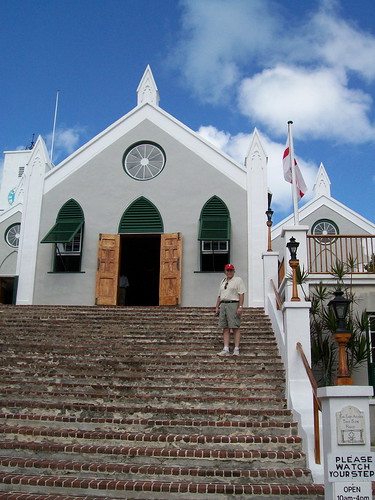
St. Peter’s Church, which dates back to 1612.
Wander down the road to The State House (built in 1620), and make sure to stop by Fort St. Catherines, which boasts spectacular views of passing ships. Do not end your day just yet; make sure you see The Unfinished Church. Upon first glance it appears to be the ruins of a neo-gothic structure but in reality it is actually the start of a new church that was never finished. If you haven’t run out of time yet, wander down to step on board onto the replica of the ship that saved Jamestown, Virginia, Deliverance! Shipwrecked on the island from their original vessel, Sea Venture, the crew used the scraps to build two smaller boats, Patience and Deliverance and sent them to continue on their original mission, to bring supplies to Jamestown, Virginia. Don’t skip the Crystal Caves, this part of the trip will take you back 30 million years!
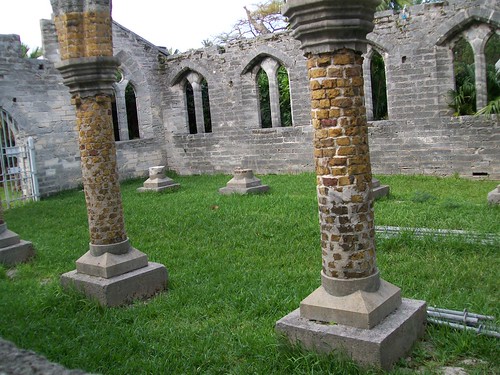
Do not end your day just yet; make sure you see The Unfinished Church
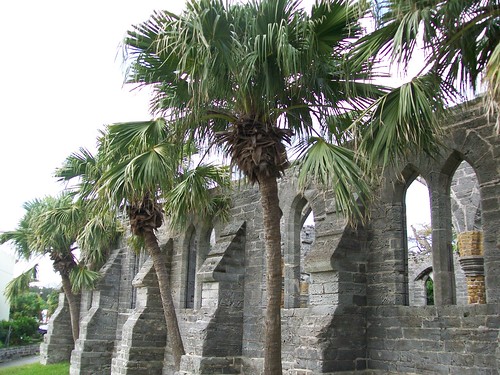
Upon first glance it appears to be the ruins of a neo-gothic structure but in reality it is actually the start of a new church that was never finished.
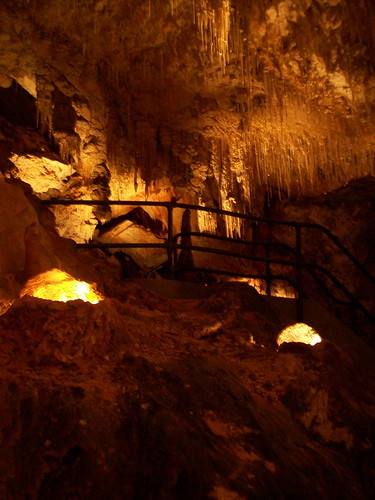
Don’t skip the Crystal Caves, this part of the trip will take you back 30 million years!
End your day by dining at Tom Moore’s Tavern. This secluded waterfront tavern takes its name from the famous Irish poet who lived there in the early 1800’s and boasts as being Bermuda’s oldest eating establishment, dating back to 1652.
Day 2 – Dockyard
Catch the 40 minute ferry ride over to The Royal Naval Dockyard and experience the immense former navel base that although is a popular tourist destination, being adjacent to the cruise docks, is also ripe with historical heartbeats. Start at the National Museum of Bermuda. A majority of this 6-acre complex remains strikingly similar to what it would have looked if you were a part of The Royal Navy in early 1800’s. Building No. 1 is also called the Queen Exhibition Hall and is home to exhibits on whaling and navigation with handcrafted models of the ship Deliverance. At one time 5,000 barrels of gunpowder were stored here and if you look down at the floors, you will see a layer of bitumen. This was done to prevent sparking from the gunpowder. The walls of the building are also constructed of 4ft thick limestone to minimize a blast from an explosion, should it occur. Around the backside is the former Shifting House (Building No. 2) this was used in 1837 to store munitions unloaded from ships. Move on to Building No. 3, which is home to a fascinating collection of bills and coins from Bermuda’s past. Building No. 4 displays historical maps and antique items from early explorers and Building No. 5 also known as the Forter Cooper Building, is a former cooperage, which constructed the barrels necessary to store everything from ale to supplies to gunpowder. Last but not least is the Boatloft (Building No. 6). This hosts the remains of the island’s maritime heritage, which contains a collection of handcrafted dinghies and boats constructed from Bermuda cedar trees and oversized sails. Lastly, wander into the Commissioner’s House; constructed in 1823 by convicts, to become the home of the Commissioner of Bermuda. It is now a museum that displays Bermuda’s historical contributions to the world. Before you call it a day and head to the pub for some refreshments be sure to walk the perimeter of the keep and take in the thick fortress walls (completed with old cannons) and spectacular views. Time for that drink? Head over to The Frog and Onion which gets its name from the owners, a Frenchman (frog) and Bermudian (onion). This pub/eatery is located inside a spectacular stone building called The Cooperage, where barrels were once made. This establishment now makes delicious food and brews its own local beer. My favorite Frog and Onion meal? The frog and onion burger with blue cheese crumbles and a pint of dark porter ale, hits the spot every time.

Be sure to walk the perimeter of the Royal Naval Dockyard's immense former navel base keep and take in the thick fortress walls (completed with old cannons) and spectacular views.
Day 3 – Explore the West End
Are your legs tried yet from all that walking? No? Good, because on day three your legs are going to get their workout climbing 185 steps to the top of Gibb’s Hill Lighthouse. Learn more before you go by reading my past article on Gibb’s Hill here. Drive across Somerset Bridge, the smallest drawbridge in the world on your way to Scaur Hill Fort. This fort offers breathtaking views of the Great Sound and Ely’s Harbor. On a clear day you can see both ends of the island from Dockyard to St. George’s. This is a great spot for a picnic lunch. Next stop: Heydon Trust. A large property, with 43 acres of meticulously preserved grounds and a tiny, charming chapel, built on the hillside. It is thought to have been an early homestead, dating back to at least 1616 that was converted into a church. Take a peek behind the altar and you will see the home’s original oven. Besides the historical signifigance of this site, Heydon Trust is also home to native wildlife and is an excellent bird watching perch. Cap off your third day by dining at Henry VIII. This is considered Southampton’s best-known restaurant that plays up Old English ambiance with dark wood and deep set corner pockets for intimate dinning experiences. The fare is pub friendly for lunch but dinner is what they do best. Serving up Angus prime rib with the bar topping off pints of English lagers on tap will fill your belly. Looking for something lighter? Try the poached salmon or curried vegetable strudel. Service is quick and friendly and if your visit is during the summer months, opt to sit outside on the patio, the view is not to be missed.
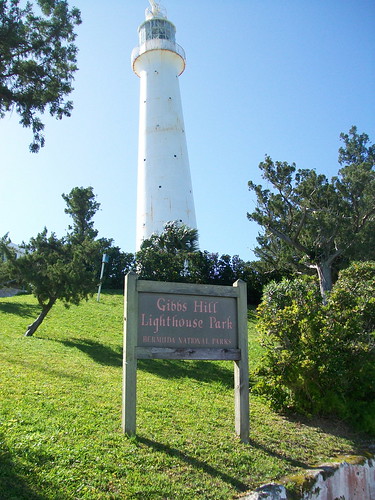
On day three your legs are going to get their workout climbing 185 steps to the top of Gibb’s Hill Lighthouse.
Day 4 – Explore the East End including Hamilton
Start your last day by traveling through time to the year 1710 in the Georgian style, on the corner of Collector’s Hill and Sayle Road. Verdmont, a National Trust Property, houses a unique collection of Bermuda cedar furniture, period paintings, dishes, children’s furniture and toys. Moving into Hamilton, start at the fort whose moniker reflects the town, Fort Hamilton. Boasting panoramic views of the city, this hilltop fort is the perfect starting point for your foray into the city. Constructed in the mid-19th century, Fort Hamilton remains a symbol of the time. The large ramparts host muzzle-loader guns that, at the time, were capable of firing a 400lb cannon ball through 11inch thick metal plate. Thankfully, they were never needed to defend the city, as it was never attacked. If you have time, check out the dungeon-like magazine where you’ll discover a multitude of rooms that stored everything from munitions storage to gun embrasures. If you’re visiting during the winter months, plan your visit to the fort on a Monday, when the kilted bagpipers and drummers of the Bermuda Islands Pipe Band perform.
Moving down into the heart of Hamilton, note the Sessions House. This building encompasses Bermuda’s 40-member House of Assembly and its Supreme Court. Although the building dates 1817 much of it’s beautiful façade, including the clock tower, were added in 1887, to mark Queen Victoria’s golden jubilee. Head next to the Bermuda Cathedral, this beautiful and neo-Gothic building is a dominant landmark. The original church, built in 1844, was unfortunately burnt down by an arsonist but in 1894, the church was redesigned as a cathedral, built of native limestone block and remains that way today. With beautiful stained glass windows and lofty arches, the name cathedral is fitting to such a structure. The best part of all? For a small donation, you can climb the 157 steps to the top of the tower for unreal 360-degree views of Hamilton and the inner harbor.
Wind your day down by having a relaxing dinner at Hog Penny. The minute you step inside you’ll experience the feeling of being in a British pub. They offer up British, Bermudian, and East Indian food that is reliably tasty. Be sure to order up a bowl of their Bermudian fish chowder ($7) with spiced rum and sherry pepper sauce. Although it’s Bermuda’s specialty dish, Hog Penny’s in particular is excellent. Want to bring your Bermuda vacation back to its British roots? How about bangers and mash for your entrée followed by Yorkshire pudding for dessert?
As you sip your dark n’ stormy while you discuss your trip forwards and backwards through Bermuda’s past; digest one last tid bit of Bermuda gossip and lore. Did you know that there are over 400 shipwrecks dating back to the 1500’s here in Bermuda? Local legend says that Wreck Island reached via Wreck Road is thusly named because locals would lure ships towards the island to run aground on the enormous reef surrounding the island. They would then paddle out and for a hefty price, help you come to shore. If you refuse, they would just relieve you of your cargo instead. Sounds a little bit like going through customs at the airport...
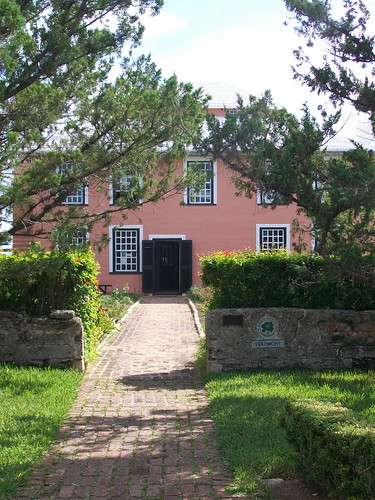
Start your last day by traveling through time to the year 1710 in the Georgian style, on the corner of Collector’s Hill and Sayle Road. Verdmont, a National Trust Property, houses a unique collection of Bermuda cedar furniture, period paintings, dishes, children’s furniture and toys.
Lindsey Lehman is the Bermuda Editor for Wandering Educators
All photos courtesy and copyright Lindsey Lehman
-

- Log in to post comments





















